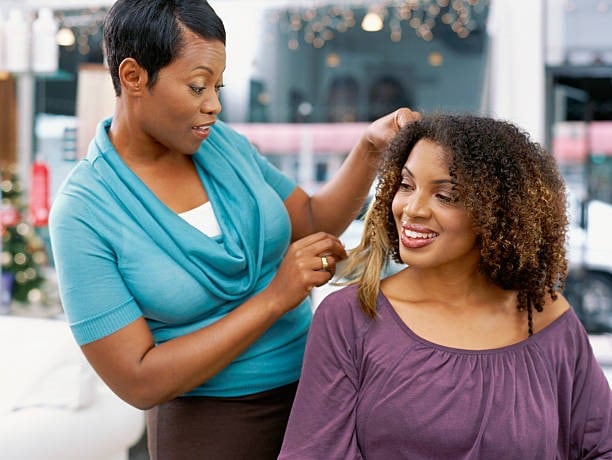How to color your hair safely and really understand the cancer/hair dye connection.
Many women were frightened and confused by the latest statistics on breast cancer and hair dye or straighteners, released in a December 4, 2019 study conducted by the National Institutes of Health (NIH). The NIH research was the latest to report what appeared to be a dramatically higher risk of breast cancer for women — especially black women — who regularly used hair dyes and straighteners. Fierce reached out to the lead NIH investigators, along with the lead investigator from a 2017 study conducted at Rutgers’ University that reported similar results, to learn more about the likely real level of risk for the average black woman and how that risk can be lowered. Here’s what we found:
Q: Did the latest research out of NIH prove that there was a cause and effect link between hair dye or hair straightener and breast cancer? The American Cancer Society and Rutgers University have also reported a possible link. Does the research fully answer the question?
A: “We did not establish a cause and effect relationship between hair dyes or straighteners and breast cancer,” explains Alexandra J. White, PhD, head of the Environment and Cancer Epidemiology Group, at the National Institutes of Health and lead investigator on the December 2019 study.
Adana Llanos, PhD, an assistant professor of epidemiology at Rutgers School of Public Health and the Rutgers Cancer Institute of New Jersey, says that “both of our studies found an association between the use of certain products and breast cancer.” That means a connection was observed, but it’s not clear that dyes or straighteners directly cause the disease. “We need larger studies, with larger numbers of black women to learn more,” Llanos says, also citing the limitations of studies conducted on women with different health histories using a wide selection of hair products with different formulas.
Q: What were the big differences in the women who participated in the studies?
A: “We used data from the Sister Study,” White says. “The women in the study did not have breast cancer upon joining the study, but they did have a higher risk than the general population because they all had sisters or half-sisters with breast cancer.” There were 46,709 women, ages 35-74. Of the group, 4,087 women were black. The 2017 Rutgers study included 4,285 women from the Women’s Circle of Health Study — 2,280 (1,508 African American women) with breast cancer, 2005 (1,290 African American women) who did not have breast cancer. In the NIH research, scientists observed changes in the group. In the Rutgers work, a case/control study, breast cancer risk was assessed by comparing the two groups of women.
Q: The dye/straightener/breast cancer risk levels reported by NIH and Rutgers seemed very high, but some experts have said the reported risks really represent a small to moderate increase for the average woman. Can you explain?
A: The NIH study reported that black women who used permanent hair dye had a 45 percent higher risk of developing breast cancer. “In the general population, this actually translates to a 7.6 percent higher absolute risk of developing breast cancer by age 70,” says White, who explains that the 45 percent number was produced in relation to the baseline study population. For chemical straightener use, the relative breast cancer risk reported in the NIH study was 20 percent, the average woman should really see that “as a 3.5 percent higher absolute risk by age 70,” White says.
The 2017 Rutgers study found a 51 percent increased risk of breast cancer associated with hair dye use. “Our 51 percent increased risk represents risk associated with the exposure examined among the cases [women with breast cancer] compared to the controls [women without breast cancer] enrolled in our study,” Llanos says. “We are not comparing it to women who might be at average risk in the general population.”
Q: What was the strongest breast cancer/hair product association found in both the NIH and Rutgers’ research?
A: “There is an association with permanent dyes,” says Llanos, especially darker dyes. White’s NIH research also found a stronger correlation between permanent hair dye, especially if it was used every six to eight weeks. The research found little or no risk associated with semi-permanent dyes, temporary dyes (see examples below), cholesterol or placenta conditioners. Henna, vegetable, and organic dyes were not specifically tested.
Q: Why did the NIH study report a much higher breast cancer/hair product risk for black women?
A: The differences reported may not be based on race, so much as the frequency of use and the type of products used. For the NIH study, the association for chemical straighteners did not vary by race. The women in the study who used hair straighteners at least every 5 to 8 weeks, regardless of race, were 31 percent more likely to get breast cancer. However, 74 percent of black women and 3 percent of the white women studied reported using chemical straighteners. Therefore, chemical straighteners may appear to be a more important contributor to breast cancer in black women, because of the frequency of use compared to other groups. It’s not clear.
For hair dye, the risk estimate for the association with breast cancer was higher in black women, although frequency of use was not very different. It may be that the type of dye (dark) or differences in absorption through hair texture play a role.
Q: How do hair dyes and straighteners contribute to the development of breast cancer?
A: Researchers cannot answer this question definitively because dyes and straighteners have a wide range of ingredients, but both White and Llanos noted that most dyes and relaxers likely contain endocrine disruptors. These are chemicals that may mimic the body’s hormones and interfere with normal hormonal activity. Some endocrine disruptors are considered synthetic estrogens and may therefore contribute to the development of certain cancers.
Q: How can women color their hair safely and protect themselves from hair product related risks?
A: Consider some changes to how you take care of your hair. All natural, whether that means letting your gray shine through or getting rid of your relaxer, may be the healthiest choice.
For color, permanent hair dye carries the highest risk, so henna and semi-permanent formulas are worth a try. The only hair color without added chemicals is pure henna powder (with indigo added for brown or black formulas). The Light Mountain company offers a regular product line and a product just for gray hair.
Another choice is using semi-permanent hair color. Clairol’s Natural Instincts gets good consumer reviews. Temporary color also appears to be safe, but it won’t last very long.
If you want more natural ingredients, Tints of Nature’s semi-permanent color line is vegetable-based and vegan. Also, consider going a few shades lighter, as darker dyes have a stronger association with breast cancer. Bleaching (primarily using hydrogen peroxide) damages hair, but so far, there’s no link to cancer.
Hair relaxers are another story. There’s no such thing as a completely non-toxic, harmless relaxer. All need chemicals to straighten hair. Keratin treatments (including those that claim to be formaldehyde free) still contain some form of formaldehyde in order to straighten hair. That leaves heat or (for some hair textures) blow drying or wet-setting as safer options.
Q: What do the researchers want women to learn most from their work?
A: “Again, we need more research,” White says, emphasizing that the NIH study is not the last word. She also wants women to use the findings on dye and straighteners, along with knowledge about other cancer risks, to create a healthier lifestyle. “Our findings on dye and breast cancer risk show a level of risk similar to obesity and breast cancer, but dye poses a slightly lower risk than alcohol consumption.”
“Our work is not intended to scare women,” Llanos says. “The goal is to increase awareness about the many things we put on our bodies — cleaning products, skin care products — that may be harmful so that women can make informed decisions.” Her upcoming work, conducted with the Environmental Working Group, will be an effort to look more closely at specific personal care products and ingredients and cancer risk.
Sheree Crute is editor-in-chief and co-founder of Fierceforblackwomen.com.








